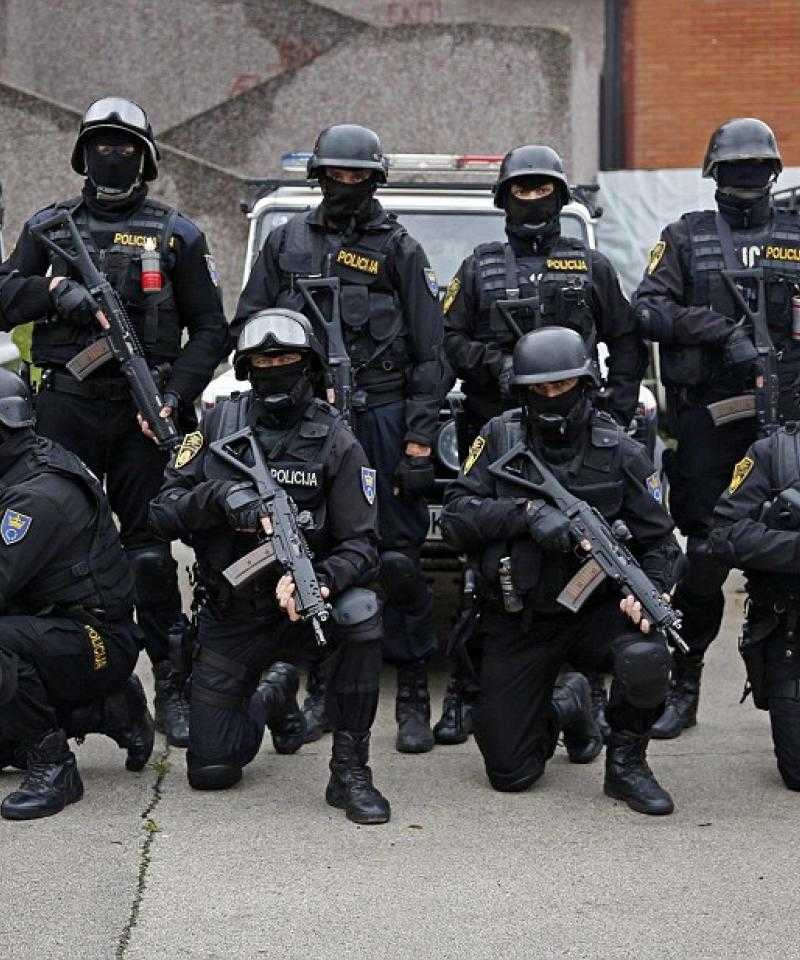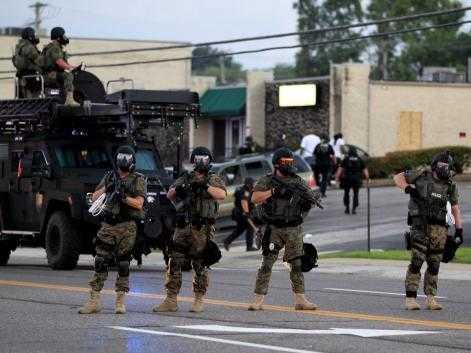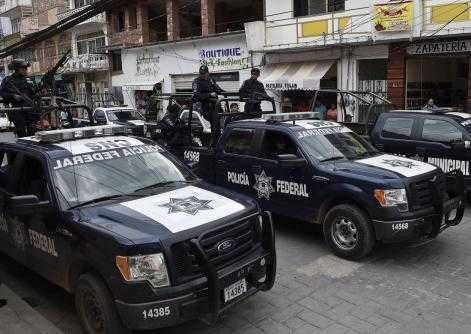Police militarisation is global

As antimilitarist activists, we are well positioned to see the power of police within wider weapons industries and militarist agendas. Understanding this police power as it plays out in different contexts around the world is critical in enabling activists against militarisation to keep the power of police in check within our communities. Police forces often act to maintain unjust 'status-quo' distributions of power in society, and tend towards hegemonic, 'power-over' approaches, and especially when the perception of threat is elevated - the police are a form of social control, and militarisation increases their power. Militarism is guns, armored tanks and drones, but it’s also a state of mind. Militarised mentalities have permeated many police forces and amplified dramatically the force of police violence against our communities.
“If one sees policing for what it is - a set of practices empowered by the state to enforce law and maintain social control and cultural hegemony through the use of force - one may more easily recognize that perhaps the goal should not be to improve how policing functions but to reduce its role in our lives."
This article will set out examples of how police forces around the world are going through a process of militarisation. What is police militarisation? To become 'militarised' is as much a social and psychological process as a technical one – a militarised worldview perceives difference as a threat, and believes (often extreme) violence is a primary means of responding to a (perceived) threat. The discourse of 'counter-terrorism' and 'the war on drugs', which in various contexts have led to citizens of a state being treated in much the same manner as an external, state military enemy are examples of this; the lines between the role of the police and the military are blurred. Militarised mentalities mean that:
-
maximum escalation is always available as a solution;
-
police forces rely on control, use or the threat of force, and cultures of fear;
-
the poor, ethnic minorities of a country, or political activists are enemies and dehumanized;
-
police have extreme discipline, absolute hierarchy, anonymity, and patriotic hyper-masculinity.
Feeding this process, arms companies are developing new weapons and marketing approaches – there are now several international trade expos specifically aimed at bringing the arms industry together with police and security forces. Companies are international, as are their venues for vending, and this is reflected in our movement's resistance; after the militarised occupation of Ferguson’s Black communities in the United States in 2014, hundreds of Palestinians supported U.S. activists through social media with how to alleviate tear gassing or identify tear gas canister companies.
As the stresses placed on populations by climate change, economic inequality, population growth, and conflict over resources increase, it is easy to see how states will increasingly turn to militarise their police forces as a 'response', through the militarisation of domestic police forces, paramilitary forces, national guard, border patrols or emergency preparedness institutions. As our movements demanding for economic, racial and gender justice continue to organise, we will continue to see the ever-militarising faces of police on the frontlines of protests as they attempt to suppress and control people power.
On the surface (and on the street) this militarisation is seen in the use of heavier weaponry and more extreme violence. The weaponry and equipment being used by police forces is an indicator of much deeper trends and practises of state repression and maintaining social hierarchies through brute force. As organizers who often face the force of police militarisation against our nonviolent actions and uprisings, we call on activists worldwide to question why policing is a part of our human life, what ideas of safety our societies have constructed that uphold police institutions, and to share how we are practicing alternatives to policing, where we de-escalate situations, where we transform violence, where our communities have created social fabric to keep ourselves safe.
United States
Police militarisation in the United States cannot be separated from the everyday brutality of beat cops in neighbourhoods across the country who are regularly and disproportionately harming and violating communities of colour with impunity. Police departments uphold the injustices embedded within the racist fabric of US society, for example, a Black person is killed by someone employed or protected by the police every 28 hours; trans and gender non-conforming people are far more likely to experience police violence than others; and, entire units of police departments are devoted to surveillance of Muslim people. These injustices depend on a climate of fear, where emergencies are always imminent – caused by anti-Black, anti-migrant, and anti-Muslim racism, compulsory gender normativity, criminalization and political reaction to freedom struggles - and the response must include SWAT tanks, tear gas and assault rifles.
While police militarisation as an industry and a practice of merging US domestic policing with the internationalised US military industrial complex has been in effect for decades (and some will argue that because the history of police in the US were created to “catch” escaped enslaved people, they were always an army), the phenomenon of police militarization as part of the war on terror is a fairly new industry & phenomenon. According to Professor Pete Kraska of Eastern Kentucky University’s School of Justice Studies there were 50,000 SWAT raids in 2015; SWAT (Special Weapons and Tactic) teams are dressed in military gear and weapons, assault a home and forcefully enter, often throwing grenades first - this estimates to be 137 raids a day nationally. As the number of SWAT teams has grown nationwide, so have the raids.
Police militarisation is a process that is directly funded from the federal government and military departments. For example, the Urban Areas Security Initiative (UASI)--a federal grant program of the Department of Homeland Security (DHS) of almost $600 million, administers funding to cities around the US for trainings and weapons expos (such as Urban Shield), but also for police departments to obtain war toys, such as Chicago’s surveillance cameras, BearCat tanks in Fargo, ND and Keene, NH and Long Beach’s armored cars.
Israel / Palestine
A third of the police force in Israel is MAGAV (“Border Police”). This unit recruits via conscription, and is part both of the Israeli military and the Israeli police. While the name, “Border Police” infers they are responsible for securing the borders, MAGAV deal mostly with borders between populations - between Israeli-Jews and Palestinians - and also assists the riot police in “controlling demonstrations”, thus blurring the lines between “fighting terror” and “controlling demonstrations”. The MAGAV draws the line between the two by ethnicity rather than actual action.
Because the Israeli army isn't fighting a formal Palestinian military, the Israeli police and army do the same thing - control a civil population in the name of “security”. The main difference is the legal status of the population targeted, and whether they function due to military rule in the West Bank or according to state rule in Israel. The MAGAV have led raids on unrecognised villages such as Al-Arakib, which is inside the 1967 Israeli borders, in a similar manner to that of the army raiding villages in the West Bank. The law restricts the police from using the live ammunition and rubber bullets that are used by the army, but weaponry such as tear gas, skunk (a foul smelling liquid spray) and sponge bullets, often used by the army in the West Bank, are used to disperse demonstrations within the green line as well. This is mostly seen in east Jerusalem, at demonstrations of minority populations such as ultra orthodox, Israeli Jews of Ethiopian origin, and obviously, Palestinian citizens of Israel.
United Kingdom
In the wake of the 7/7 attacks,'London riots' in 2013 and the Daesh attacks in Paris in 2015, there have been increasing calls for more police in the UK to carry firearms, and for all police officers to be trained to use electric tasers. Politically marginalised communities are those most likely to feel the impact of police violence - as described by Betsy Barkas in a previous edition of WRI’s Broken Rifle magazine, "the UK’s Black and migrant communities have always suffered disproportionately heavy policing... there is a long and shameful history of the use of lethal force by the UK’s police officers."
Recently, several high-profile police training exercises have taken place, designed to test their response to an extremely violent "marauding" terrorist attack. These have been heavily publicised in the media.
The UK also hosts the annual “Security and Policing” trade show. According to Campaign Against the Arms Trade, the show is “a secretive annual event organised by the Home Office and the arms industry trade body, Air Defense Security Space (ADS).” The organisers promote Security and Policing as "the UK's premier security and law enforcement event". The fair hosts companies like BAE Systems, Heckler and Koch, the Gamma Group and The Hacking Team, who promote their wares to 66 countries, including those committing human rights abuses.
Turkey
Turkey has a history of military dictatorship, and the police are part of this history. The Özel Harekat Timleri (or ‘Special Operation Teams’) were established by the military government in the 1980s, and continue to be active. They are heavily armed, work alongside the military, and have been given extensive powers under a recent security bill, including powers to conduct strip searches and car searches, the power to detain (previously only the judiciary had this power), more autonomy on the use of firearms, and increasing the amount of time the police can run wire taps without the permission of a judge. After a bomb attack in Ankara in October 2015 - the deadliest in Turkey’s history - police used tear gas to prevent pro-Kurdish politicians and mourners from laying flowers at the site of the attack.
South Africa
After the end of Apartheid in 1994, there were moves to 'demilitarise' the police - during the years of Apartheid, both the police and the military were used to maintain the oppressive status-quo, and the police had far-reaching powers. During the transition from apartheid, new ranks were introduced to 'demilitarise' the police, and police were retrained to 'manage' rather than 'control' crowds. However, with high crime rates, there are growing calls for the police to extend their capabilities, and deal with crime with 'an iron fist'. Military rankings for the police were reintroduced in 2010, and the South African Police Service has been trained by French police, in techniques described as 'paramilitary' and reliant on shows of force. In the autumn of 2012, heavily armed police forces shot 34 striking miners in the now infamous Marikana massacre - the BBC reported that weaponry available to the police that day included a 40mm vehicle mounted machine gun.
Chile & Peru
The links between the police, militarisation and extractive industries were explored in detail in a previous edition of the WRI magazine ‘The Broken Rifle’; Cesar Pedilla described how the rejection of extractivism as an economic model by swathes of the population is leading to greater use of the police and military to enforce a failed economic model across the continent of South America. For example in Chile, the 'Special Forces' were dispatched to the village of Caiman to break up a three month nonviolent community blockade countering the impact of a mine. Similarly, the Yanacocha mine in Peru is infamous for the violence used by it’s private guards.
Brazil
In the preparation for the 2014 World Cup, and 2016 Olympic Games, the Brazilian government has relied heavily on Israeli arms, training and expertise in preparation for the ‘security’ apparatus surrounding these mega-events. The local Olympics committee has recruited the Israeli company International Security and Defence Systems (ISDS) to coordinate the whole security apparatus of the games, with a budget of $2.2million. A detailed write-up of this contract can be found here. In 2013, there were widespread protests in Brazil; “the unprepared and overreacting police forces responded in a way that shocked the largely middle-class protesters. The police, using “non-lethal” weapons like pepper spray and rubber bullets while dressed from head to toe in ninja-like full battle gear.” (Source: WOLA).
Afghanistan
As part of ongoing military occupation of Afghanistan, both the U.S. military & U.S.-backed Afghan police often use a tactic known as "night raids." Targeting homes in the middle of the night, these operations involving heavily armed troops barging into homes, detaining, assaulting, terrorising & sometimes murdering people. In a report from 2011, "[After his father and older brother were shot dead] 11th grader Abdullah was hooded, handcuffed & flown to prison, where he was detained for questioning & then released." Though leading to 100s of deaths over the last 14 years, and sparking outrage across Afghanistan, the U.S. Special Operations forces continue to carry out nights raids on homes suspected to be associated with Taliban, without any judicial process, and a high level of civilian casualties.
France and Belgium
Source: http://www.democracynow.org/2015/12/3/state_of_emergency_in_france_2
In the aftermath of Daesh’s attacks in Paris, 2,200 police raids were conducted throughout France, as well as 330 house arrests, the shutting down of 3 mosques and hundreds questioned. An additional three mosques were trashed (that were already under heightened surveillance) by French authorities. One such raid resulted in a six-year-old injured by shrapnel from police firing through the door. Under the state of emergency, French police can raid any home without judicial oversight. The vast majority of those targeted in the raids have been Muslim.
The attacks coincided with the planning of the COP21 event, when representatives of states from around the world would debate international responses to climate change. The state of emergencymeant that activists taking part in peaceful, nonviolent, and in many cases otherwise entirely legal protest actions were threatened with mass arrest and serious legal consequences - at the same time corporate events and christmas markets were given permission to go ahead.
Burundi
Mass protests in April 2015, in response to President Pierre Nkurunziza’s decision to seek a third electoral term resulted in political upheaval and widespread killings by the security forces and armed opposition groups. Police used excessive force and shot demonstrators indiscriminately. 20,000 people fled Burundi in fear of civil war returning. After July’s disputed presidential election that returned Nkurunziza to power, government forces, armed opposition groups, and unknown assailants killed hundreds of people. The government arrested hundreds of suspected opponents, often arbitrarily, as well as launching a crackdown against civil society activists and journalists, as well as banning protests. Source: https://www.hrw.org/africa/burundi
Mexico
While private possession of firearms is illegal for almost all individuals in Mexico, from 2010 to 2015--the most violent period in Mexican memory--the country’s military sold 255,712 non-military weapons of various kinds (pistols, rifles, shotguns, among others) to police agencies, private companies and the general public, including sport shooters, hunters, and for land and home protection. During the same period, the military’s income from these sales – through the Directorate for Weapons and Munitions Trade of the General Office of Military Industry – reached 570 million pesos [about US$34 million]. Income from these sales to the Mexican military more than doubled during the period, from 58 million pesos in 2010 to 127.6 million in 2014. More than 98% of weapons sold were imported by the Mexican military. Only 4,761 were produced in Mexico, and most were imported from the United States. Weapons sales to state police agencies show 156,419 arms acquired by local police, including 16,759 weapons to Mexico state and 10,846 to Michoacán (most of those in 2010).
Source: http://afsc.org/story/mexican-military-sold-255712-weapons-2010-2015
Egypt
Source: Issa, Ali. “Resistance and Persistence: An Interview with Aida Seif al-Dawla of the El Nadeem Center”, The Abolitionist #25, Winter 2016.
The uprisings of 2011 had anti-policing roots due to the history of police brutality in Egypt. The murder of Khaled Said in 2010, and the terrible photos of his murder as well as the determination of his family went viral on social media, making him an icon of the movement against torture and policing. This following the temporary withdrawal of the police from Tahrir Square in 2011 reinforced the feeling of triumph among protesters, and the challenge to police authority continued through the months following the ousting of Mubarak. In particular, the January revolt stands as a landmark due to the young women leadership present, who then faced virginity tests, arrests, media defaming and organized rape in Tahrir Square and other gatherings. Centers, such as El Nadeem, continue to work for psychological rehabilitation for victims of torture for both poor and marginalized people, as well as political activists. El Nadeem recognized torture as “rampant and used for a variety of reasons beyond forcing confessions- to induce terror, to punish, and to accentuate police power” and finds torture used in police stations, prisons, security kiosks, campuses, metro stations and state security headquarters. As Aida Seif al-Dawla stated, “torture maintains the power of the rulers.” (El Nadeem is currently facing the threat of closure by the Egyptian government but vowing to fight the order until the end!)
Source: Issa, Ali. “Resistance and Persistence: An Interview with Aida Seif al-Dawla of the El Nadeem Center”, The Abolitionist #25, Winter 2016.
Summary
In examples from all over the world, we have seen how the line between traditional state militaries and civilian police forces are blurred, and that the wars of states are being fought within their borders - often against their own people - by police forces. However, resistance against these processes is also growing - every time activists assert their rights to assembly and expression, and take part in protests for the social change we so deeply need despite the threat of extreme violence from the police, they are also resisting these processes of militarisation, declaring that they will not work. We would welcome more information on cases of police militarisation in other countries, greater discussion on its causes and impact, and stories of resistance against these processes.


Add new comment